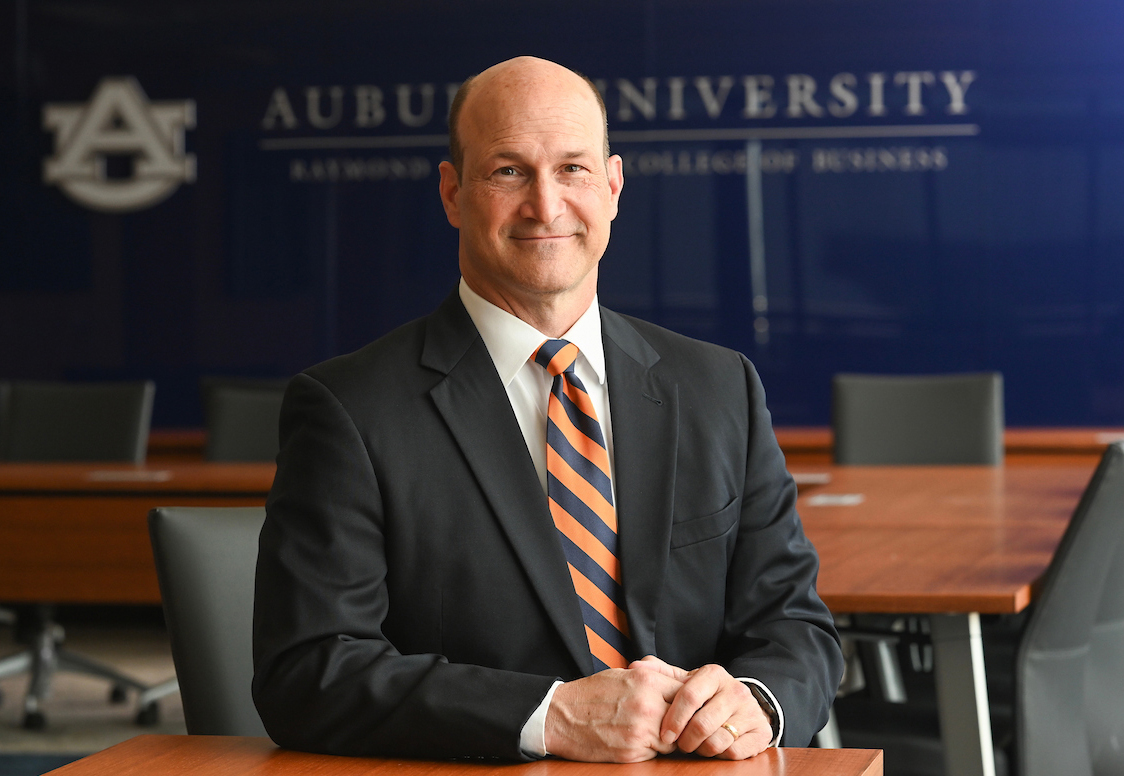 |
Harbert College of Business Instructor Erik Sjolseth (right) moderated the panel discussion.
|
A panel of industry experts at the CityBuilders symposium, The Future of Industrial Development and Logistics, explored the uptick in industrial real estate development tied to unprecedented shifts
in global supply chains that occurred as a result of the COVID-19 pandemic. CityBuilders
is an annual initiative of Auburn University’s Institute for Real Estate Development and number one-ranked Master of Real Estate Development (MRED) program.
Moderated by Erik Sjolseth, instructor in the Department of Supply Chain Management at Auburn’s Harbert College of Business, The Current Landscape and Outlook for Logistics and E-Commerce session featured five leading real estate developers and logistics experts sharing
their experience and insight with the 180 professionals in attendance. The panelists
were presented with a number of issues to discuss, and a sampling of their remarks
is presented here.
Sjolseth: What changes in design and services do you think are needed for the evolving industrial
development market when it comes to the transportation sector?
Mike LaFerle, Vice President — Real Estate/Construction, The Home Depot
From our perspective, it is all about the people who work in our facilities—we have
about 350 million square feet under roof, with 100 million of that industrial. Air
conditioning, transportation and on-site amenities such as animal care, for example,
are important to both current team members and potential employees when they decide
where to work—or continue working. I can't tell you how many of our people have to
leave during their breaks to go home and feed or walk a dog or whatever it may be.
Public transportation is also a bigger challenge these days—how can we make it easier
to get people to large industrial campuses that may not be in an urban area?
Stacy Watson, Director, Economic & Industrial Development, Georgia Ports Authority
What keeps us up at night is the workforce as well. We need more people, more folks
in the labor pool. We have 100 million square feet of industrial space within 30 miles
of our terminal—we've been the fastest growing U.S. port for the last 15 years in
terms of containers, and we need people to move, store and load or unload those containers.
There’s a lot of competition for these folks—they have options as to who they work
for and where they’re willing to go. Their needs matter a lot.
Scott King, LEED Green Associate, Senior Vice President, Industrial & Commissioning Project &
Development Services, JLL
The majority of what we’re dealing with is which employee amenities need to be included
in the design of the environments we build or redevelop. These days we're going into
a lot of existing facilities and upgrading bathrooms, locker rooms, break areas and
trying to figure out how we make it better for workers, make it different from the
companies and operations they compete with for employees. Companies need more than
buildings—they need workers. It’s an incredibly competitive labor market out there.
Sjolseth: How does a company or organization decide on the optimal location for a new distribution
center or warehouse?
Adam Langston, Chief Commercial Officer of Passport Shipping
We typically talk about the first mile and the last mile, but since the pandemic,
when people started running out of space and needed more flexibility, there's been
an emerging type of ecosystem around what we'll call the ‘middle mile.’ We need to
develop innovative solutions as to where these types of facilities are built and what
they need to contain. For example, sometimes deliveries and pickups happen in personal
vehicles—how do we deal with that? How does the building itself need to be designed
to accommodate these changes?
Denson White, Chief Commercial Officer at APM Terminals
In a place like Los Angeles, we are looking at re-purposing existing facilities vs.
building new ones. We used to have million square foot warehouses that were full of
goods from a single company. Now those are getting chopped up into smaller units.
We're having to go in and totally revamp these huge buildings that are out there because
the market has changed. We're looking at remodels, looking at revamps to add all the
amenities today’s workers are expecting. This employee-focused factor totally changes
the mindset—it could mean the difference between getting the labor the client needs
in order to compete or their competition getting them.
The availability of land is becoming a challenge, especially when coupled with the
need for infrastructure, power, water, and community engagement. It's a big country,
and it looks like there's a lot of land, but once you start adding up the requirements—a
rail stop, higher capacity roads, sustainable power sources, etc.—the number of viable
sites diminishes quite a bit. And the price of that land is going up.
Sjolseth: What are the biggest challenges facing your supply chain-related real estate strategy?
Reducing the “dwell time” of a container box—how long it sits at the port after it
comes ashore or before it is loaded—is our main focus. The inland port concept can
help. A port is built to move freight, not to store freight, even though over the
last couple of years we've been making a lot of money storing freight—but that’s not
what we're designed to do. The inland port concept actually gives us the ability to
move freight through our terminal faster, basically extending our terminal gates closer
to the population, closer to where there's demand for that freight.
For Home Depot, the challenges are two-fold. First, ensuring the availability of the
products our customers need. Second, making sure we have those products close enough
to the customer that they can get them in a timely fashion, be it same day or next
day. We have what we call upstream and downstream facilities. The upstream facilities
are those where we receive and store goods to be distributed—we have four and a half
million square feet in Savannah and another 12 million square feet here in Atlanta.
We also have downstream facilities closer to the customer, where the population density
demands it.
I’ll add the exporter perspective on this. About 70% of our costs are in the first
mile and the last mile of a shipment. About 20% of that is an international air freight
component. Only about four percent of our costs are in the rent we pay for the real
estate we occupy. So it’s really all about driving first mile and last mile efficiency
for us.
We have too much in our supply chain right now, and as a result, we're spending more
on warehousing. For example, we are working with an auto manufacturer—negotiating
how to store about 1,000 containers—and they are telling us that those containers
might sit there until the end of the year. That’s what we’re dealing with now—how
to accommodate the ever-changing needs of our customers.

 Degrees & Programs
Degrees & Programs
 Faculty & Staff
Faculty & Staff
 Career Development
Career Development
 Recruiters & Industry
Recruiters & Industry








